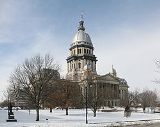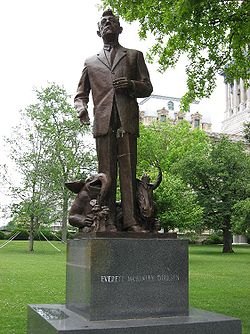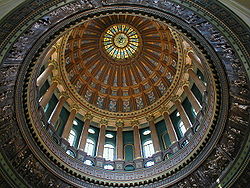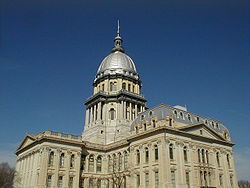
Illinois State Capitol
Encyclopedia
The Illinois State Capitol, located in Springfield, Illinois
, is the building that houses the executive
and legislative
branches of the government of the U.S. state
of Illinois
. The current building is the sixth capitol of the state since its admission as a state of the United States
in 1818. The current capitol is in the architectural style of the French Renaissance
. The capitol was designed by Cochrane and Garnsey
, an architecture and design firm based in Chicago, Illinois. Ground was first broken for the new capitol on March 11, 1869, and it was completed twenty years later for a total cost of $
4,500,000.
The capitol dome is covered in zinc to provide a silvery facade which does not weather. The interior of the dome features a plaster frieze painted to resemble bronze, which illustrates scenes from Illinois history, and stained glass windows (including a stained glass replica of the state seal in the oculus
of the dome). The seal featured in the top of the dome is the seal used by Illinois
prior to the American Civil War. It differs from the modern seal in that the phrase "State Sovereignty" is above the phrase "National Union." After the Civil War, the legislature voted to reverse these phrases as they professed that National Union was the more important of these two concepts.
 With a total height of 361 feet (110 m), the Illinois capitol is the tallest non-skyscraper capitol, even exceeding the height of the United States Capiapitol building, however it is on lower ground, making the Capitol building higher. A city statute does not allow buildings to be built higher than the Capitol building. The building itself is shaped like a Latin cross aligned to the major compass directions, and measures 379 feet (116 m) from the north end to the south end, and 268 feet (81.7 m) from the east end to the west end. The capitol occupies a nine acre
With a total height of 361 feet (110 m), the Illinois capitol is the tallest non-skyscraper capitol, even exceeding the height of the United States Capiapitol building, however it is on lower ground, making the Capitol building higher. A city statute does not allow buildings to be built higher than the Capitol building. The building itself is shaped like a Latin cross aligned to the major compass directions, and measures 379 feet (116 m) from the north end to the south end, and 268 feet (81.7 m) from the east end to the west end. The capitol occupies a nine acre
plot of land which forms the capitol grounds. William Douglas Richardson served as one of the principal contractors for the construction of the capitol building, and Jacob Bunn, an in-law of W. D. Richardson, served as chairman of the capitol construction steering committee.
 When the capitol was constructed, several empty shafts were included for the future installation of elevator
When the capitol was constructed, several empty shafts were included for the future installation of elevator
s. The original water-operated elevators were installed in 1887 and were sometimes the subject of ridicule by local newspapers as they were deemed inadequate for a building with the prestige of the State Capitol. It is unknown when the first electric elevators were installed, but the first mention of them occurs in 1939, when the legislature appropriated $30,000 for repair of the electric elevators.
, a city on the Mississippi River
founded by the French in 1709. Kaskaskia had been the territorial capital of Illinois since 1809, so it was deemed an appropriate location for the capital of the new state. The first capitol building was rented by the state and was by all accounts a simple two-story building which the state leased for $4.00 a day.
Wishing to site the capital in the state's interior, the first General Assembly petitioned Congress for a grant of suitable land. Congress offered, and the state accepted, a land parcel on the Kaskaskia River
about eighty miles northeast of Kaskaskia. This location, which would be named Vandalia, Illinois
, was selected partly with the hopes of encouraging settlers to relocate to other parts of the state which were still uninhabited. The state let its lease on the first capital in Kaskaskia expire (the building burned in 1824, and Kaskaskia was destroyed by a sudden change of the course of the Mississippi River
in 1881).
In 1820, with the completion of the new, or "Second", capitol, Vandalia became the capital of the state. A third capitol was soon built for a cost of $15,000. Soon after its construction, many citizens began to advocate relocating the capitol to a location nearer the center of the state. A bill was introduced in 1833 for a statewide vote to determine a new location from a list of several choices including Alton, Jacksonville, Peoria, Springfield, Vandalia, and the state's actual geographic center. While Alton was the victor, the legislature determined the margin too small to be conclusive, and the vote was ignored. In 1836, a young lawyer named Abraham Lincoln
, along with colleagues of his of the legal profession, began to advocate moving the capital to Springfield
. That summer the third capitol was demolished and replaced with the fourth capitol (built at a cost of $16,000) in an effort to keep the capital in Vandalia. Although the new brick structure was extravagant, the General Assembly ignored the gesture and voted to relocate the capital to Springfield on February 25, 1837.
 On July 4, 1837, the first brick was laid for Illinois' fifth capitol. In 1853, the capitol was completed for a total sum of $260,000, almost twenty times the cost of any such previous structure. The building was designed in the Greek Revival style from stone quarried six miles (10 km) from the site. For many years, it was the largest and most extravagant capitol of the western frontier of the United States. The fifth capitol is associated with Abraham Lincoln
On July 4, 1837, the first brick was laid for Illinois' fifth capitol. In 1853, the capitol was completed for a total sum of $260,000, almost twenty times the cost of any such previous structure. The building was designed in the Greek Revival style from stone quarried six miles (10 km) from the site. For many years, it was the largest and most extravagant capitol of the western frontier of the United States. The fifth capitol is associated with Abraham Lincoln
as it was here that he argued cases before the Illinois Supreme Court, here that he served with the State Legislature, here that he first debated Stephen Douglas, here where he delivered his famous "House Divided
" speech, and here where he lay in state after his assassination
on May 4, 1865.
As Illinois prospered and experienced several great increases of population, the fifth capitol became crowded, especially as a result of relocations after the Civil War. On February 24, 1867, the state voted to construct a new larger capitol. After beginning the sixth and current Capitol in 1868, the state recouped its costs for the fifth capitol by selling it to Sangamon County
for $200,000. It was the county court house until 1961 when the state again purchased the building and restored it to be a historic landmark, the Old State Capitol State Historic Site
.
Springfield, Illinois
Springfield is the third and current capital of the US state of Illinois and the county seat of Sangamon County with a population of 117,400 , making it the sixth most populated city in the state and the second most populated Illinois city outside of the Chicago Metropolitan Area...
, is the building that houses the executive
Governor of Illinois
The Governor of Illinois is the chief executive of the State of Illinois and the various agencies and departments over which the officer has jurisdiction, as prescribed in the state constitution. It is a directly elected position, votes being cast by popular suffrage of residents of the state....
and legislative
Illinois General Assembly
The Illinois General Assembly is the state legislature of the U.S. state of Illinois and comprises the Illinois House of Representatives and the Illinois Senate. The General Assembly was created by the first state constitution adopted in 1818. Illinois has 59 legislative districts, with two...
branches of the government of the U.S. state
U.S. state
A U.S. state is any one of the 50 federated states of the United States of America that share sovereignty with the federal government. Because of this shared sovereignty, an American is a citizen both of the federal entity and of his or her state of domicile. Four states use the official title of...
of Illinois
Illinois
Illinois is the fifth-most populous state of the United States of America, and is often noted for being a microcosm of the entire country. With Chicago in the northeast, small industrial cities and great agricultural productivity in central and northern Illinois, and natural resources like coal,...
. The current building is the sixth capitol of the state since its admission as a state of the United States
United States
The United States of America is a federal constitutional republic comprising fifty states and a federal district...
in 1818. The current capitol is in the architectural style of the French Renaissance
French Renaissance
French Renaissance is a recent term used to describe a cultural and artistic movement in France from the late 15th century to the early 17th century. It is associated with the pan-European Renaissance that many cultural historians believe originated in northern Italy in the fourteenth century...
. The capitol was designed by Cochrane and Garnsey
Cochrane and Garnsey
Cochrane and Garnsey was a Chicago, Illinois-based architectural firm. John C. Cochrane and George O. Garnsey were the principals.-External links:...
, an architecture and design firm based in Chicago, Illinois. Ground was first broken for the new capitol on March 11, 1869, and it was completed twenty years later for a total cost of $
United States dollar
The United States dollar , also referred to as the American dollar, is the official currency of the United States of America. It is divided into 100 smaller units called cents or pennies....
4,500,000.
The capitol dome is covered in zinc to provide a silvery facade which does not weather. The interior of the dome features a plaster frieze painted to resemble bronze, which illustrates scenes from Illinois history, and stained glass windows (including a stained glass replica of the state seal in the oculus
Oculus
An Oculus, circular window, or rain-hole is a feature of Classical architecture since the 16th century. They are often denoted by their French name, oeil de boeuf, or "bull's-eye". Such circular or oval windows express the presence of a mezzanine on a building's façade without competing for...
of the dome). The seal featured in the top of the dome is the seal used by Illinois
Seal of Illinois
The Great Seal of the State of Illinois is the official emblem of the State, and signifies the official nature of a document produced by the State of Illinois.-History:...
prior to the American Civil War. It differs from the modern seal in that the phrase "State Sovereignty" is above the phrase "National Union." After the Civil War, the legislature voted to reverse these phrases as they professed that National Union was the more important of these two concepts.
Description

Acre
The acre is a unit of area in a number of different systems, including the imperial and U.S. customary systems. The most commonly used acres today are the international acre and, in the United States, the survey acre. The most common use of the acre is to measure tracts of land.The acre is related...
plot of land which forms the capitol grounds. William Douglas Richardson served as one of the principal contractors for the construction of the capitol building, and Jacob Bunn, an in-law of W. D. Richardson, served as chairman of the capitol construction steering committee.

Elevator
An elevator is a type of vertical transport equipment that efficiently moves people or goods between floors of a building, vessel or other structures...
s. The original water-operated elevators were installed in 1887 and were sometimes the subject of ridicule by local newspapers as they were deemed inadequate for a building with the prestige of the State Capitol. It is unknown when the first electric elevators were installed, but the first mention of them occurs in 1939, when the legislature appropriated $30,000 for repair of the electric elevators.
Former capitols
The current Capitol of Illinois is the sixth such building in the history of the state. The first was located in Kaskaskia, IllinoisKaskaskia, Illinois
Kaskaskia is a village in Randolph County, Illinois, United States. In the 2010 census the population was 14, making it the second-smallest incorporated community in the State of Illinois in terms of population. A major French colonial town of the Illinois Country, its peak population was about...
, a city on the Mississippi River
Mississippi River
The Mississippi River is the largest river system in North America. Flowing entirely in the United States, this river rises in western Minnesota and meanders slowly southwards for to the Mississippi River Delta at the Gulf of Mexico. With its many tributaries, the Mississippi's watershed drains...
founded by the French in 1709. Kaskaskia had been the territorial capital of Illinois since 1809, so it was deemed an appropriate location for the capital of the new state. The first capitol building was rented by the state and was by all accounts a simple two-story building which the state leased for $4.00 a day.
Wishing to site the capital in the state's interior, the first General Assembly petitioned Congress for a grant of suitable land. Congress offered, and the state accepted, a land parcel on the Kaskaskia River
Kaskaskia River
The Kaskaskia River is a tributary of the Mississippi River, approximately long, in central and southern Illinois in the United States. The second largest river system within Illinois, it drains a rural area of farms, as well as rolling hills along river bottoms of hardwood forests in its lower...
about eighty miles northeast of Kaskaskia. This location, which would be named Vandalia, Illinois
Vandalia, Illinois
Vandalia is a city in Fayette County, Illinois, United States, northeast of St. Louis, on the Kaskaskia River. From 1819 to 1839 it served as the state capital of Illinois. Vandalia was the western terminus of the National Road. Today it is the county seat of Fayette County and the home of the...
, was selected partly with the hopes of encouraging settlers to relocate to other parts of the state which were still uninhabited. The state let its lease on the first capital in Kaskaskia expire (the building burned in 1824, and Kaskaskia was destroyed by a sudden change of the course of the Mississippi River
Mississippi River
The Mississippi River is the largest river system in North America. Flowing entirely in the United States, this river rises in western Minnesota and meanders slowly southwards for to the Mississippi River Delta at the Gulf of Mexico. With its many tributaries, the Mississippi's watershed drains...
in 1881).
In 1820, with the completion of the new, or "Second", capitol, Vandalia became the capital of the state. A third capitol was soon built for a cost of $15,000. Soon after its construction, many citizens began to advocate relocating the capitol to a location nearer the center of the state. A bill was introduced in 1833 for a statewide vote to determine a new location from a list of several choices including Alton, Jacksonville, Peoria, Springfield, Vandalia, and the state's actual geographic center. While Alton was the victor, the legislature determined the margin too small to be conclusive, and the vote was ignored. In 1836, a young lawyer named Abraham Lincoln
Abraham Lincoln
Abraham Lincoln was the 16th President of the United States, serving from March 1861 until his assassination in April 1865. He successfully led his country through a great constitutional, military and moral crisis – the American Civil War – preserving the Union, while ending slavery, and...
, along with colleagues of his of the legal profession, began to advocate moving the capital to Springfield
Springfield, Illinois
Springfield is the third and current capital of the US state of Illinois and the county seat of Sangamon County with a population of 117,400 , making it the sixth most populated city in the state and the second most populated Illinois city outside of the Chicago Metropolitan Area...
. That summer the third capitol was demolished and replaced with the fourth capitol (built at a cost of $16,000) in an effort to keep the capital in Vandalia. Although the new brick structure was extravagant, the General Assembly ignored the gesture and voted to relocate the capital to Springfield on February 25, 1837.

Abraham Lincoln
Abraham Lincoln was the 16th President of the United States, serving from March 1861 until his assassination in April 1865. He successfully led his country through a great constitutional, military and moral crisis – the American Civil War – preserving the Union, while ending slavery, and...
as it was here that he argued cases before the Illinois Supreme Court, here that he served with the State Legislature, here that he first debated Stephen Douglas, here where he delivered his famous "House Divided
Lincoln's House Divided Speech
The House Divided Speech was an address given by Abraham Lincoln on June 16, 1858, in Springfield, Illinois, upon accepting the Illinois Republican Party's nomination as that state's United States senator. The speech became the launching point for his unsuccessful campaign for the Senate seat...
" speech, and here where he lay in state after his assassination
Abraham Lincoln assassination
The assassination of United States President Abraham Lincoln took place on Good Friday, April 14, 1865, as the American Civil War was drawing to a close. The assassination occurred five days after the commanding General of the Army of Northern Virginia, Robert E. Lee, and his battered Army of...
on May 4, 1865.
As Illinois prospered and experienced several great increases of population, the fifth capitol became crowded, especially as a result of relocations after the Civil War. On February 24, 1867, the state voted to construct a new larger capitol. After beginning the sixth and current Capitol in 1868, the state recouped its costs for the fifth capitol by selling it to Sangamon County
Sangamon County, Illinois
Sangamon County is a county located in the U.S. state of Illinois. According to the 2010 census, it has a population of 197,465, which is an increase of 4.5% from 188,951 in 2000...
for $200,000. It was the county court house until 1961 when the state again purchased the building and restored it to be a historic landmark, the Old State Capitol State Historic Site
Old State Capitol State Historic Site
The Old State Capitol State Historic Site, in Springfield, Illinois, is the fifth capitol building built for the U.S. state of Illinois. It was built in the Greek Revival style in 1837-40, and served as the state house in 1840-1876...
.
External links
Fourth Statehouse
- Located in Vandalia, 38.961199°N 89.093980°W
- Illinois Historical Preservation Agency, Vandalia Old State Capitol
- Vandalia Old State Capitol
Fifth Statehouse
- Located in Springfield, 39.801219°N 89.648569°W
- Illinois Historical Preservation Agency, Springfield Old State Capitol

